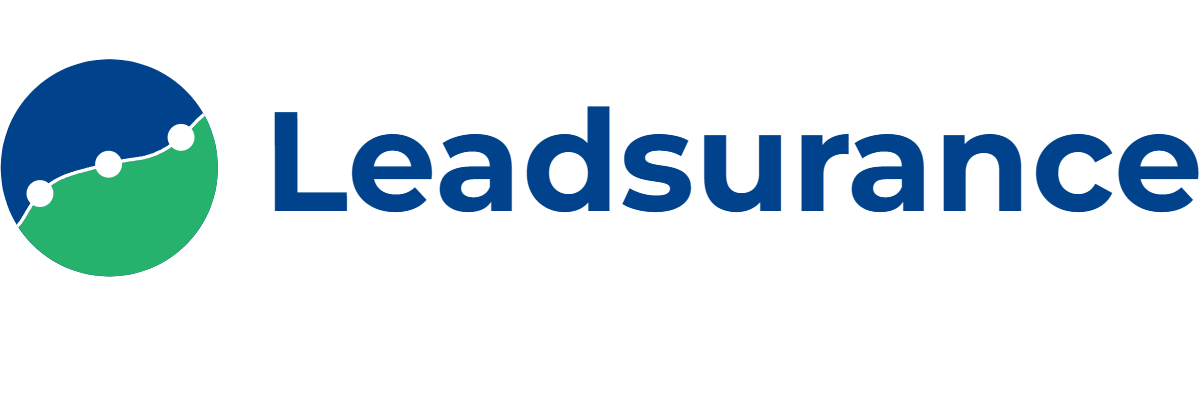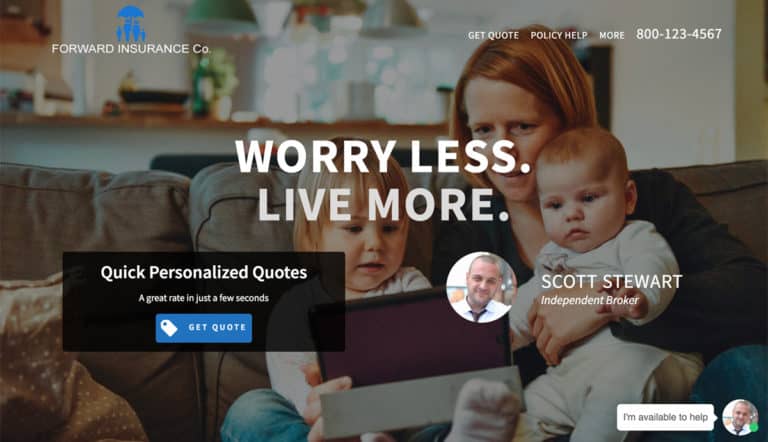When launching a new website, you want to make sure you are getting the word out to as many people as possible.
The common ways to do that are through advertisement, social media, and email.
Advertising is a great option if you have the budget for it. You will be able to reach thousands of people who are interested in what you are promoting.
Social media is a great alternative to advertising since it is free. You can share your new website with all of your friends on all sorts of social media networks including Facebook, Twitter, Linkedin. You can also create a business page that promotes your site and company. Don’t over-complicate this, share some informational insurance posts and you can even share funny insurance memes from time to time.
Email is another great option. Get a database together of all the people you want to reach out to and send out a mass email promoting your new site.
These are a few of the obvious ways to launch a new website but in today’s post, we are going to share some lesser-known methods used by professional digital marketers.
HARO: Help A Reporter Out
Our #1 Tip is from Expert Source: Anthony Martin, CEO Choice Mutual
A new website should immediately start laying the foundation to rank organically in Google and other search engines. First, subscribe to HARO and begin to respond to any query that you are qualified to. This will land you high-quality backlinks which are essential to ranking in search engines.
When the queries are emailed out, stop what you are doing and respond to as many as you can to the best of your ability. This should net you about 10 links per month.
At the same time, begin to produce high-quality content that is designed to answer your customer’s questions. More specifically, begin by focusing on long-tail keywords rather than short phrases.
For example, if you sell car insurance, do not try to create content meant to rank for “car insurance”.
That keyword is much too difficult and likely is impossible to rank for.
However, a long tail phrase such as “car insurance for a 19-year-old in Mississippi” is much easier to rank for.
Its highly specific so big companies won’t have content for that query. A new website could rank #1 in Google for that phrase due to how specific it is combined with a lack of competition. In the end, continually pump out high-quality content that is designed to satisfy search intent and your articles will show up in Google.
As mentioned, you’ll initially build out content meant to rank for long-tail phrases. As time goes on and your domain authority rises, you can then really start to rank for shorter more competitive keywords that have much higher search volume. Make these two tasks your weekly focus and before you know it, you’ll be getting organic traffic that delivers high intent buyers on a regular basis.
Announce the Website Pre-Launch
Don’t wait to launch the website to announce it, announce it before you even launch it. Start building interest and then when it launches you will have a waiting line of traffic to see it.
Once you’ve built your website, you need to create as much buzz as you can before actually releasing it. Concentrate your pre-launch outreach only on websites that are in your industry, they are much more likely to take an interest than larger media outlets. Let them know of your launch date, how they can help you i.e. post on their social media and how you can help them i.e. a guest post. Repeating this process for say 5-10 websites will create elastic energy that will unlock new traffic come launch day.
A lot of businesses don’t realize that creating their social media page even before an official launch of their site can go a long way in generating traffic. As an example, business owners “build suspense” with a holding page containing a short write-up that gives potential readers an idea of your product’s value, and an e-mail subscription.
Owners can then run content about the problem that the product can solve for potential clients, and syndicate it to their social media pages to build a following. The end goal pre-launch is to use social media and the holding page to generate e-mail subscriptions so that upon launch, direct traffic can be immediately generated by e-mail announcements to the already-primed followers in the e-mail list.
On the day of launch, you want to be as active as you can. Be sure to reply to every comment on social media. Network with potential customers. Have conversations over the phone. Be as personable as you can. If you’re a founder, you should especially be at the frontline. The idea behind this exercise is to get potential and/or existing customers to really LOVE what you do. It takes a lot of effort to make them feel special but it will reap big rewards in the future. Think about a product/service you’ve loved. Have you recommended that business to your friends and family as if you were their own salesperson? You get the idea 🙂
Sources: Amit Gami, Business Waste Guru & Gordon Hayden, Khepri Digital
Test Your Sales Funnel
When launching a new business website my number one tip is to make sure your website sales funnel is already operational before going live. In 2020 a simple branded website is no longer enough to compete. You need an efficient way to attract, capture, and convert website visitors into leads and customers.
That’s where your sales funnel comes into play. Your sales funnel could be simple, or complex.
At Leadsurance we use a simple and effective insurance chatbot to engage visitors and offer assistance and insurance quotes. The bot captures the user’s information and passes it to the insurance agency to follow up with the lead.
If a first-time visitor to your new company website has no way to transact with you, they’ll likely poke around for a little bit and then leave and never come back. Your sales funnel is how you can keep in touch with, and remarket to your visitors over the years giving you multiple opportunities to convert them into customers.
Source: Sam Rexford, CHILLREPTILE
Press Release
When you finish building your new website for your business, whether that is an insurance agency or not, a press release is a fantastic way to launch the new website. Here are a few reasons why press releases will help you launch your new website:
- The links in the press release pointing to your website will help your brand new website get crawled and indexed by Google and Bing.
- You can target demographics and verticals when you distribute your release so you may even generate a lead if you reach your target audience effectively.
- Press releases help your brand presence online by having various news sites mention your company and your website.
- Press releases can also be published on your own blog to help build credibility with the audience directly on your website.
There are even more reasons to send out a press release when you launch your new website but the above 4 should be enough to convince you to send out an announcement.
If you have a budget, you can opt for paid PR services too where the content will be published on hundreds of news sites. For example, Newswire is a credible press release distribution service. The best thing about this service is that it allows you to select the relevant industry you wish to target for your press release. And on top of it, even lets you reach Local Media in Print, TV, and Radio.
The results that it can drive for your website is a lot of traffic, social shares, and hundreds of backlinks from high authority websites. All of this would help a new website gain traction and improve search engine visibility.
Press releases do not have to be very long and you can find simple to follow templates online. Talk about the highlights, features, and benefits of your new website and how it will better serve your clients.
For an insurance website, you can talk about how you’ve added a policyholder center to make it easy to get documents and file claims. You can also include a screenshot of your new homepage or maybe even a short video recording scrolling on the website or clicking around.
Create a Content Plan and Pipeline
Before you start creating content, make sure to create a content plan. Research what your competitors are ranking for, what your target audience is searching for, which keywords look interesting and how those three things intersect with the knowledge, services, and/or products you have to offer.
Making a plan allows you to put together a content calendar for the year so that you’ll always know what to write about next and make sure that each piece of content contributes to building authority for your brand.
It’s not just enough to know which keyword you want to target each time you publish a post, though. You’ll also need to analyze which articles are currently ranking for that keyword. This will teach you what both Google and readers consider a good article on the topic (if the algorithm does what it’s supposed to do, that is).
Prepare a lot of content before launch. When a site is first launched, there are so many tasks to be done that content often gets forgotten. I strongly recommend that you prepare at least one month’s worth of content before launching.
The main thing that retains visitors to a new website is content, so you definitely don’t want to be found wanting in this area. Creating high-quality content before launch will not only retain visitors but will also improve your chances of ranking and getting backlinks.
Sources: Sam Cohen, Goldtreeway and Sofie Couwenbergh, letmewritethatdownforyou.com
Link Building and Outreach
Prior to launching your website, you will want to perform on-page SEO to make sure your site is crawlable and relevant for your search terms. Immediately upon launching the new website you will also want to run an SEO audit on the live site to make sure everything checks out and the site is getting crawled and indexed by Google and Bing.
Once you’ve done your on-page and technical SEO, the next stage is to work on your off-page SEO – i.e. link building. And while part of that is going to be building citations and business directory links – you will want to also get a bit more creative and perform outreach. This involves reaching out to other websites relevant to your website and showing them your content to see if they would like to link to it. Or perhaps they’ll allow you to contribute an article to their website (and give you a link as credit).
It sounds simple enough, but your success rate will really be determined by how good your content is, or if you have some other kind of value exchange (e.g. discount codes, free access, sharing their article on social media or your newsletter, etc)
Here are some ideas for insurance agents to use:
- Offer a free consultation to the other website’s audience in exchange for a link in a blog article on the site that links to your site and mentions your business.
- Offer a free consultation to the website owner in exchange for the opportunity to write an article about insurance for their website and include a link in your article that points to your website.
- Follow our guide to linkbuilding for insurance agents as well as our guide on SEO for insurance agents to really launch your insurance website properly.
Text Your Customers
Before the launch of a new website, it’s common to create a splash page. This is just a simple landing page that lets visitors to the URL know the website is coming soon. A successful splash page lets you start advertising your site before it’s launched. There are plenty of ways to do this: PPC ads, sponsored posts, influencers, the list goes on.
But here’s the key—you need to collect info from the visitors. Not just emails, but phone numbers too.
Otherwise, you’ll get traffic to the splash page but few of those visitors will come back. Why? Because fewer and fewer people are clicking on emails. It’s an oversaturated channel.
According to Mailchimp, the average click-through rate of emails is just 2.62%. On the other hand, links sent by text message have a CTR of 17%. It’s even higher if you include the link in an MMS message with a photo.
It’s not hard to collect phone numbers on landing pages. All you have to do is create a form and include a checkbox that asks visitors for their express consent to receive text messages.
Source: Alfredo, SimpleTexting
Notify Your Network
One of the tips I recommend people when they start their website and want to get traffic is using your existing network of people and company’s to promote you.
It’s extremely difficult to get website traffic when you are just starting a website. Reaching out to your existing network of company’s and people you have worked at or with in the past can give you a flying start.
Send out an email telling your existing customers that you are launching a new website and tell them what are new features that are included in the new website.
Include videos and visuals about how the new website looks, how the new features work in the latest website. You may want to consider offering a discount or promotion for being used on the new site.
Regardless, make your email content easy to understand and exciting. Also, edit your email signature and add “Check out our new website!”, linking to the new site.
Any customers, prospects, employees or partners would love to receive this email and hear about the launching of your new company website. Evangelists in your network will also help further promote your site to their networks.
This gives you an easy way of getting your first backlinks and traffic to the site. This gives you a starting boost with your end-goal being consistent organic traffic.
Source: Riddhi Khatri, Elsner
Ego Bait Your Partners and Clients
Do you have any real estate or mortgage partners? What about accounting partners? Do you have client testimonials on your website?
Many successful insurance agents and agencies partner with a variety of other service professionals in order to refer business back and forth. One of the most common examples of this is when a Mortgage Lender refers new home buyers to a local insurance agency to purchase home insurance.
So, if your insurance agency as partnerships with other local businesses, or testimonials from customers, then you can use them to promote your new website launch.
One of my favorite tactics is called “ego baiting”. This is a perfect way of getting clients or partners to share your content about the new website launch.
For example, we will offer to feature our partners, or other client’s businesses, in a piece of content that highlights what they do on our website. In exchange, we ask them to share the content on their social channels.
Since the content featuring them will be going live when the website launches they will be highly motivated to share. This process not only makes your partners gain free exposure but it also helps you send social signals to Google to get your site launched and indexed in search engines.
Source: Josh Eberly, Glanzair
Be a Twitter Resource
Become a Helpful Resource on Twitter This is so simple you may wonder why everyone is not doing it, but the truth is they aren’t.
Use your Twitter profile to send out helpful advice and don’t always link back to your website, instead create advice that actually helps people. Use the Twitter search features to find questions being asked in your industry and start helping people in message threads by answering those questions.
You can use this Twitter tactic to build up your personal or business brand and the more momentum you get will naturally lead to more followers who start to trust you and in many cases will visit your website. Don’t be afraid to retweet other helpful information not only from big brands and influencers but also from your average Twitter user.
Just make sure your goal is to help people. As part of your routine use daily searches on Twitter to find people talking about your competitors or products/services they sell. If people are asking about a product or service or question in your field then be helpful and answer it even if there is no business to be won at that stage.
This is all part of becoming a trusted resource. Being helpful on Twitter builds trust, increases brand exposure, gains followers, and will get more people to visit your website to make inquiries even if they previously used to deal with your competitors.
Source: Zak Jacobs, RAD
Start Blogging, Immediately!
Not only should you create a blog post announcing your new website, but you should also prepare an entire content calendar full of insurance blog topics prior to launching your website.
Your content calendar should be full of well-researched topics that are going to help your target buyer through the marketing and sales funnel.
So, when you launch your new website, start publishing blog posts early, and track performance.
When launching a new website, it will take some time for search engines like Google to add the blog posts to their index. Sometimes it can take a couple of weeks, but other times a few months or longer. The earlier you start publishing blogs, the earlier you will see a return on investment from them.
It’s also incredibly important to track their performance from the get-go. You can post as many blogs as you’d like, but if you don’t know which posts are performing well and why it will be incredibly difficult to make improvements in the future.
Here are 3 metrics you should track from day one to get the most out of your investment:
- Search queries the blog posts are showing for (Google Search Console)
- Click-through rate, bounce rate, and time on page numbers (Google Search Console and Google Analytics)
- Heat maps that show where users are interacting with your blog posts and where improvements need to be made
At Leadsurance, we offer a marketing analytics dashboard so that you can track data from Google Search Console and Google Analytics within your Leadsurance account and see how well your blog posts and other content on your website is performing.
Source: Karr Fager, Digital Panther
Add Your Link on Business Cards & Email Signatures
Your business cards should include a URL to your website. For example, https://myinsuranceagency.com should be visible on all of your business cards.
If you really want to stand out, at a QR scan code to the back of your business cards that takes users directly to your website. If you do this, I still recommend having your full domain name such as https://myinsuranceagency.com written out on the front to help people remember the URL.
You should also update your email signature to include a link to your new website that is being launched.
Here are some tools to help you add your URL to your business cards and email signatures:
Clearly State Your Website’s Value & USP
You are going to be promoting your website through a variety of channels. It is important to clearly state the value your website offers customers and prospects.
One of the most crucial elements in launching a new website and introducing its brand to the world; is having a Unique Selling Proposition or a USP.
Without a USP, you would struggle to tell your brand story for the first time, scale incoming traffic across multiple channels and help website visitors understand what separates your offering from the rest of the market.
That sense of uniqueness is what makes new brands desirable and interesting. It motivates potential customers to engage, query, purchase and come back for more.
So, find out what sets you apart from your competition.
- Are you a bit expensive but provides an exemplary service experience that will save your clients a lot of “headaches”?
- Or maybe your online platform is so advanced and effective that it makes the user experience by far better than your direct competitors.
- Is it easier to find product information?
- Do you have a new live-chat or chatbot function?
- Can people find your press releases and testimonials more easily?
With a Leadsurance website you would want to tell customers that your new website is user friendly, fast, easy to find policy help, and you can get instant quotes 24/7 in just a minute of your time.
Focus your message on things that provide tangible value on the new website, not things like having a new look and feel, which are harder to define and are subject to taste. Deliver for your audience and you are well on the way to a successful launch of your new company website.
Once you understand the strengths and weaknesses of your brand and its USP, it will become apparent for you what is the message you should engage first-time visitors with, and how to apply a consistent offering across your website, advertising channels, social activity or PR.
Source: Ron Maoz, Clever Accounts
Spend on Advertising
While organic traffic continues to enjoy popularity, your new website does need strategic marketing using paid search, social media advertising and display advertising.
Organic traffic takes time to build, sure it produces a higher ROI however from day one it won’t drive much traffic.
Google has a six month period during which new websites are placed into a “sandbox”. This means that from an organic SEO perspective your website will not rank on the search result pages.
The fastest and sure way to generate traffic is through paid online advertising.
You would choose which platform to advertise on based on your product or service, advertising budget, and resources available.
- If you are a B2B company (selling commercial insurance for example) then you would consider advertising on LinkedIn or Google Search.
- If you are a B2C insurance agency selling Home, Auto, Health and Life for example then Facebook, Instagram or Pinterest would be better-suited advertising platforms for reaching consumers.
If you have limited budget and resources, I would suggest picking only one platform and focusing on that rather than spreading yourself too thin and risk not making an impact.
Facebook and Instagram have millions of monthly users who can be targeted with very specific demographic and psychographic criteria allowing you to be very efficient with your budget. Reaching people who would be interested in your website and driving traffic to it can be done very easily.
Google on the other hand allows people to find you. It can convert really well as the user is aware of a problem or trying to answer a question. If your website will help them answer their question or solve their problem they will most likely want to visit it.
Whichever platform you decide to use, paid advertising to drive traffic to your new website will be the fastest and most efficient way.
So, when it comes to the day one launch of a new website, you should invest in some advertising clicks to drive traffic.
You can customize advertising campaigns to your specific goal – do you just need more traffic, or are you wishing to increase conversions too.
The simplest way to drive online ad traffic is to run Facebook Ads to your site. When you have a budget of at least $300 per month ($10/day) and you write quality copy to drive clicks, the traffic will come.
Influencer Marketing (Word of Mouth Traffic)
One of the best ways to grow a new website (or any website) is to identify who in your industry/niche has access to your target audience.
That means planning a strategy to get influencers sharing your content. Niche celebrity influencers should be avoided because they usually get too many requests so go more for mid-tier influencers – this could include bloggers, editors, etc. Anyone who has got a reasonable audience in your niche and the relevant expertise.
Editor’s Note: I know you are thinking, who is an influencer in the insurance industry? Trust me, there are many influential people online talking about insurance that you would be fortunate to have share your new website with their audience. To find some insurance influencers, check our list of the best 40 insurance blogs and also the 21 best insurance podcasts.
An easy way to do this is to invite influencers to contribute a quote to one of your articles. The finished piece of content needs to be high quality and extremely useful. Something that they would want to share with their audience.
Once the post is live, email them to say thanks and provide some quick share links (tweets they can RT, Facebook posts they can reshare, etc.) and links so they can vote on any social bookmarking platforms (Reddit or niche-specific platforms).
Because they contributed to the content, they are more invested in its success. This makes them far more likely to share than if you just mentioned them randomly in a post.
Source: Adam Connell, Blogging Wizard
Host a Podcast or Live Webinar
Podcasts and webinars are great ways to communicate with customers. You can actually talk with customers through these platforms, live back and forth.
The ability to connect with customers on this level brings a whole new dynamic to announcing the launch of your website. You could get customer feedback on the website in real-time during the podcast or webinar.
If I were trying to generate traffic to a new insurance company website, I’d host an AMA (Ask Me Anything) podcast or live webinar on a platform where our ideal customers would join in and ask questions about insurance.
To get more of their questions answered after the session ends, I’d mention that they should visit the new company website to submit topic ideas for the company’s blog. Assuming this turns out successful, I will then amplify things with PR by sharing the result (the number of hits the website received in 24 hours, 1 week, or 1 month).
Host a Giveaway or Contest
Launch a contest where the winner will receive a valuable package of some of your goods/services. You can be more conservative, allowing people to enter by subscribing, following you on social media, and of course spreading the word to their own friends and followers. Giving them more entries for every action they make can encourage even more interaction and sharing.
We run giveaways throughout the year to grow our email list and website traffic.
Alternatively, you can be as wacky as you like by making contestants take a funny photo or do something funny in order to enter. It should ideally be connected to your brand – for instance, if you sell pet insurance, they can submit images of themselves (or their pets) wearing ridiculous hats. If you do go the wacky route, ensure that this fits with the company image you are trying to promote.
This can generate a lot of attention and shares if done well, putting your brand firmly on the map.
Source: Ruti Dadash, Panthera Plus
Get Traffic from Forums
You can join forums that talk about insurance topics. Setting up your profile will allow you to post and also you can usually add a link to your website from either your profile page or signature.
When launching a new website, company, release, or whatever, it’s great to get on forums where your main audience hangs around. You can post a new thread and find a way to mention your website in it, but you don’t want to be spammy or promotional.
If you are able to come up with a catchy title to your thread, you’ll be able to generate visitors to your website.
Source: Momchil, Code Giant
Wrapping Up
A saying I’ve heard many times in the digital marketing industry when launching new websites is “Build it and they won’t come”.
This is what we’ve told clients who expected a brand new website and an instant flow of traffic to go with it. As we taught, you have to have a plan in place to drive traffic.
It helps to have an aged domain with some links pointing to it, so make sure to be patient if you are launching a website with a brand new domain.
The good thing about launching an insurance website is that you will have so many opportunities to promote your new website both online and offline.
From business cards to social media, to email marketing campaigns you should be able to get the work out to a lot of people and drive some traffic to your new website.






